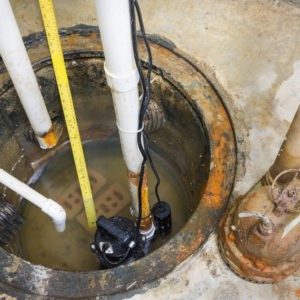Living in North East Indiana you are used to heavy rains during spring and fall. With the type of weather we get in Fort Wayne, most home owners are familiar with sump pumps.
A sump pump is an appliance that is installed in the basement of a home and keeps your basement dry and free of water damage. While a sump pump’s main purpose is to prevent a problem before a larger issues happens, sump pumps often fail without warning.
There is no method to keep sump pumps working 100% of the time, but there are different tips and tricks that home owners can follow to keep a sump pump working correctly.
Common Failures of Sump Pumps
We’ll talk about the failures of sump pumps in a moment, but let’s first get to know how a sump pump works when it is working properly. When a sump pump is installed, a hole is dug into the floor of your basement. This is the “pit” and will be the home of the actual sump pump unit.
As the pit fills up with water, the pump will turn on and begin to move the liquid through pipes and away from the foundation of your home. The water is typically sent to a storm drain, and the help of a one-way valve keeps the water from returning to the pit and away from your home!
What could cause a sump pump to fail? Let’s take a look!
1.) Power failure.
A sump pump is powered directly from your home’s main power current – no special wiring required! However, this also means that when the power goes out, the sump pump stops working. When a sump pump stops working, water begins to fill up the pit and eventually overflows into your basement.
To prevent water damage, it is important to have a backup generator ready to go for your sump pump!
2.) The sump pump was not installed correctly.
While a sump pump is a common installation, it is an installation that has to be done exactly as described in the instructions. Manufacturers recommend that check valves be installed on the water discharge line. If this is not installed water back flow can cause the sump pump to rotate backwards and unscrew the motor shaft. The motor will sound like it’s running but will actually not be pumping water away from your home.
3.) The wrong size sump pump was installed.
If the wrong size sump pump is installed, it will fail to properly remove the water from your basement. A sump pump that is too small will not be able to handle the water flow and will result in a shorter lifespan of the sump pump.
On the opposite end, if a sump pump is too large the sump pump is forced to work harder when it isn’t necessary.
4.) Mechanical problems.
The biggest mechanical mishap of a sump pump is a switch problem. A switch can move from its stationary position in the basin of the sump pump, and the float will become ineffective. The float operates the on/off switch of the sump pump, and the switch and float are required for the sump pump to work properly.
5.) Poor maintenance.
Sump pumps need service every 2 to 3 months. A larger check should be completely before the rainy season occurs to ensure that everything is in good working order.
6.) Product problems.
Product defects are rare, but they can happen. It’s always important to test your sump pump when it is first installed, and ensure that it is operating properly.
7.) Clogged discharge lines.
If the lines of a sump pump are clogged, water cannot get through to the drain. This takes away the entire point of having a sump pump – when water cannot be carried away from the foundation of your home, it becomes a prime target for flooding.
What to do if a Sump Pump Fails
If a sump pump fails it is important to first identify the issue. A broken sump pump will lead to many different problems, including the possibility of major water damage to your home.


